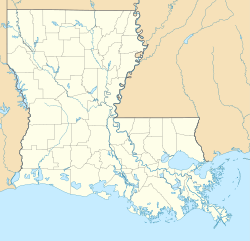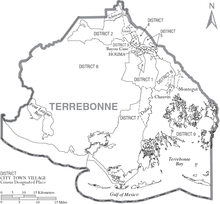
Terrebonne Parish is a parish located in the southern part of the U.S. state of Louisiana. At the 2020 census, the population was 109,580. The parish seat is Houma. The parish was founded in 1822. Terrebonne Parish is part of the Houma-Thibodaux metropolitan statistical area.
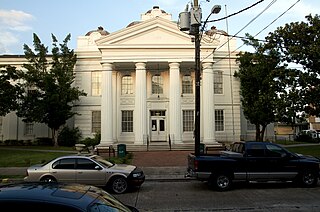
Lafourche Parish is a parish located in the south of the U.S. state of Louisiana. The parish seat is Thibodaux. The parish was formed in 1807. It was originally the northern part of Lafourche Interior Parish, which consisted of the present parishes of Lafourche and Terrebonne. Lafourche Parish was named after the Bayou Lafourche. City buildings have been featured in television and movies, such as in Fletch Lives, due to its architecture and rich history. At the 2020 census, its population was 97,557.

Thibodaux is a city in, and the parish seat of, Lafourche Parish, Louisiana, United States, along the banks of Bayou Lafourche in the northwestern part of the parish. The population was 15,948 at the 2020 census. Thibodaux is a principal city of the Houma–Bayou Cane–Thibodaux metropolitan statistical area.
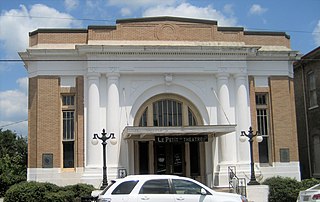
Houma is the largest city in and the parish seat of Terrebonne Parish in the U.S. state of Louisiana. It is also the largest principal city of the Houma–Bayou Cane–Thibodaux metropolitan statistical area. The city's government was absorbed by the parish in 1984, which currently operates as the Terrebonne Parish Consolidated Government.

Randall Lee Gibson was an attorney and politician, elected as a member of the House of Representatives and U.S. Senator from Louisiana. He served as a brigadier general in the Confederate States Army. Later he was a regent of the Smithsonian Institution, and a president of the board of administrators of Tulane University.
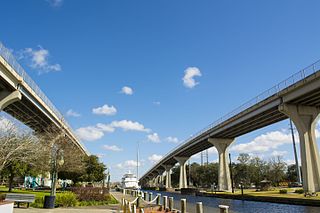
The Houma–Thibodaux metropolitan statistical area is a metropolitan area in the Acadiana region of southern Louisiana, United States that covers two parishes—Lafourche and Terrebonne. The metropolis had a 2020 census-tabulated population of 207,137.

The Edward Douglass White House, also known as Edward Douglass White Louisiana State Commemorative Area, is a state historic site near Thibodaux, Louisiana. The house was home to both Edward Douglass White, Sr., the tenth governor of the state of Louisiana, and his son, Edward Douglass White, a U.S. senator and a Chief Justice of the United States. It was designated a National Historic Landmark in 1976 for its association with the latter White, who was in the 7-1 majority ruling on Plessy v. Ferguson, 163 U.S. 537 (1896), a landmark decision of the U.S. Supreme Court that upheld the constitutionality of racial segregation laws for public facilities in a doctrine that came to be known as "separate but equal."

St. John's-In-The-Prairie, now known as St. John's Episcopal Church, is a historic Episcopal church in Forkland, Alabama.

First Methodist Episcopal Church of Perry, now known as Perry United Methodist Church, is a historic Methodist Episcopal church at Perry in Wyoming County, New York, United States. The Gothic Revival-style church is home to a Methodist congregation dating to 1816. The sanctuary design is in the Akron Plan.

Rienzi Plantation House is a historic mansion located at 215 East Bayou Road in Thibodaux, Louisiana.

Grace Church or Grace Episcopal Church is a historic Episcopal church located at 600 Cleveland Avenue in Plainfield, Union County, New Jersey, United States. It was added to the National Register of Historic Places on May 10, 2002, for its significance in architecture, art, and music from 1892 to 1930.

St. Joseph Co-Cathedral is a Catholic cathedral located in Thibodaux, Louisiana, United States. Along with the Cathedral of St. Francis de Sales in Houma it is the seat of the Diocese of Houma-Thibodaux. It is also the oldest parish in the diocese.

The Arcola Presbyterian Church is a historic Presbyterian church in Arcola, Louisiana, United States. It was built in 1859 and is of the Greek Revival architectural style. It is owned by the Amite–Arcola Presbyterian Church in Amite, Louisiana. The five-acre property was dedicated in 1859 by John Corkern and John Leonard to promote "Christianity, morality and education under the jurisdiction of the Conference of the Methodist Episcopal Church South."

St. Emma Plantation is a 13,000-acre (5,300 ha) former sugar plantation and house in Ascension Parish, Louisiana, United States.

Christ Episcopal Church and Cemetery is a historic Episcopal church on Louisiana Highway 1 between Courthouse Street and Louisiana Highway 1008 in Napoleonville, Louisiana. It was designed by New York City architect Frank Wills in a Gothic Revival style as if it were an English village church, but with adaptations for Louisiana materials. It was built in 1853 and was added to the National Register of Historic Places in 1977.

St. John's Episcopal Church and Cemetery is a historic church located at 718 Jackson Street in Thibodaux, Louisiana.

St. Matthew's Episcopal Church is a parish of the Episcopal Church in Houma, Louisiana, in the Episcopal Diocese of Louisiana. It is noted for its historic church at 243 Barrow Street, which was built in 1892 and added to the National Register of Historic Places in 1989.
The Acadia Plantation was a historic plantation house in Thibodaux, Louisiana, U.S.. It was the plantation of James Bowie, Rezin P. Bowie, and Stephen Bowie. James "Jim" Bowie, served in the Battle of the Alamo. It was listed on the National Register of Historic Places on May 29, 1987. It was demolished in 2010.
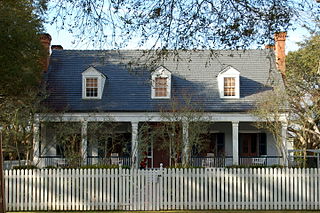
The Orange Grove Plantation House is a historic house on a former plantation in Terrebonne Parish, about eight miles away from Houma, Louisiana. It was built in 1850 for John C. Beatty, a sugar planter who owned slaves. The plantation spanned 2,470 acres of land when it was sold at auction shortly after Beatty's death in 1857. Beatty's slaves were sold with the property.
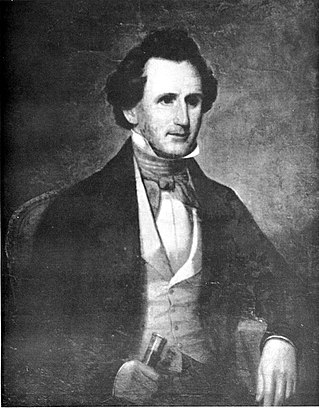
Robert Ruffin Barrow was one of the largest landowners and slave owner in the south before the American Civil War. He owned sixteen plantations, mostly in Louisiana, and had large landholdings in Texas. He also invested money in projects in which he saw potential. The most well known investment he made was in the early submarine projects of his brother-in-law, Horace Hunley, for the Confederate States Navy.

